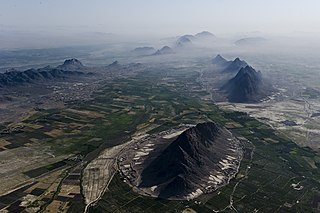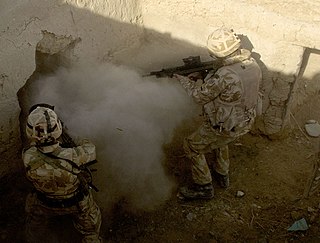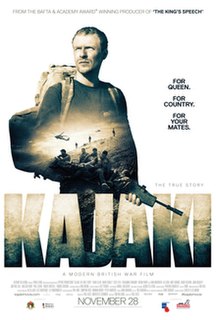
Helmand, also known as Hillmand or Helman and, in ancient times, as Hermand and Hethumand, is one of the 34 provinces of Afghanistan, in the south of the country. It is the largest province by area, covering 58,584 square kilometres (20,000 sq mi) area. The province contains 13 districts, encompassing over 1,000 villages, and roughly 1,442,500 settled people. Lashkargah serves as the provincial capital.

Lake Hāmūn or "Hamoun Oasis" is a term applied to wetlands in endorheic Sīstān Basin on the Irano-Afghan border in the Sistan region. In Iran, it is also known as Hāmūn-e Helmand, Hāmūn-e Hīrmand, or Daryācheh-ye Sīstān.

Grishk, also spelled Girishk or Gereshk, is a town in Grishk District in Helmand province on the Helmand River in Afghanistan, some 120 km (75 mi) northwest of Kandahar, at 817 metres (2,680 ft) altitude. Upstream lies the Kajaki Dam which diverts water to the Boghra Irrigation Canal, an essential infrastructure for the region's crops. Grishk Dam is also nearby. Grishk was originally built around a fort on the east bank of the river but was later rebuilt on the west. The fort was twice captured by the British: first in the First Anglo-Afghan War and again in 1879. In both cases the fort was later abandoned. Grishk has a population of about 48,546 and has a hospital and a school of engineering which was built back in 1957.
Sher Mohammed Akhundzada is a tribal leader who was the Governor of Helmand in Afghanistan from 2001 to 2005.
Operation Mountain Thrust was a NATO and Afghan-led operation in the war in Afghanistan, with more than 3,300 British troops, 2,300 U.S., 2,200 Canadian troops, about 3,500 Afghan soldiers and large air support. Its primary objective was to quell the ongoing Taliban insurgency in the south of the country.

The Kajaki Dam is one of the two major hydroelectric power dams of Helmand province in southern Afghanistan. The dam is located on the Helmand River 100 miles (161 km) north-west of Kandahar and is operated by the Helmand and Arghandab Valley Authority. It has a dual function, to provide electricity and to irrigate some 650,000 acres (1800 km2) of an otherwise arid land. Water discharging from the dam traverses some 300 miles (500 km) of downstream irrigation canals feeding farmland. As of October 2016 it produces 52.5 megawatts of electricity.

Kajaki(Pashto: کجکی) is a district in the Northeast of Helmand Province, Afghanistan. Its population is by a vast majority Pashtun, and stood at 69,300 in 2012. The district centre is the village of Kajaki. Route 611 passes through the district to the district center.

Operation Herrick is the codename under which all British operations in the War in Afghanistan were conducted from 2002 to the end of combat operations in 2014. It consisted of the British contribution to the NATO-led International Security Assistance Force (ISAF), and support to the American-led Operation Enduring Freedom (OEF). Since 2003, Operation Herrick increased in size and breadth to match ISAF's growing geographical intervention in Afghanistan.

Mark William Wright GC was a soldier in the British Army and a recipient of the George Cross. He died in Helmand Province, Afghanistan after entering a minefield in an attempt to save the lives of other injured soldiers. His actions were posthumously recognised with the award of the George Cross on 14 December 2006, and gazetted the next day. Wright had served in the 3rd Battalion, Parachute Regiment in Northern Ireland, Iraq and Afghanistan.

Kajaki is a village in southern Afghanistan, and is split between two townsteads, Kajaki 'Olya, and Kajaki Sofla. It is the district centre of Kajaki District in Helmand Province. North east of the village is an important hydro power station for electricity and irrigation projects, the Kajaki Dam. The village itself hugs the east side of the Helmand River, right after it makes its first turn south, one km out from the dam. Kajaki is bordered by the town Payson to its west, Tangeye, an abandoned bazaar to its north, Shabez Kheyl, and Kanzi to its north west, all across the Helmand. Kajaki serves as the northern terminus of Route 611.

Operation Achilles was a NATO operation, part of the war in Afghanistan. Its objective was to clear Helmand province of the Taliban. The operation began on March 6, 2007. The offensive is the largest NATO-based operation in Afghanistan to date. NATO officials reported that, contrary to previous operations, Taliban fighters were avoiding direct confrontation in favor of guerilla tactics.

Operation Volcano was a British operation to clear a village that the Taliban were using as a command and control node, consisting of 25 compounds, near the Kajaki hydroelectric dam in February 2007. The British troops came from Troops from 42 Commando, Royal Marines and 59 Commando, Royal Engineers. During the operation, the marines received fire from Taliban forces further in the compounds and from the village of Chinah. This threat was neutralized by air assets and Royal Marine's mortars. Operation Volcano was part of the March–May 2007 Operation Achilles.

Operation Lastay Kulang or Pickaxe Handle was a British-led NATO offensive in the southern Helmand province of Afghanistan. Lastay Kulang began on May 30 and ended on June 14, 2007, with 2000 ISAF and Afghan National Army troops taking part. The mission was a direct follow-up of Operation Achilles that ended on the same day.

The Helmand province campaign was a series of military operations conducted by the International Security Assistance Force (ISAF) forces against Taliban insurgents in the Helmand Province of Afghanistan. Their objective was to control a province that was known to be a Taliban stronghold, and a center of opium production.

Operation Eagle's Summit was a military operation conducted by ISAF and Afghan National Army troops, with the objective of transporting a 220-tonne turbine to the Kajaki Dam in Helmand Province through territory controlled by Taliban insurgents. Ending in success for the coalition, it involved many British troops, and was said to have been one of the largest logistical operations carried out by the British Army since World War II. The operation took its name from the eagle pictured on the insignia of the 16th Air Assault Brigade.
Route 611 is the main road between Nahri Saraj District and Kajaki District in Helmand Province, Afghanistan. The southern terminus is at Highway 1 in the town of Grishk and the northern terminus is in the village of Kajaki. The road is approximately 100 kilometers and passes through the town of Sangin. 3rd Battalion 8th Marines were deployed in 2010 to provide security for the 100km of roadway to ensure the completion of the project.

Kajaki: The True Story, released in North America as Kilo Two Bravo, is a 2014 British war docu-drama film directed by Paul Katis in his feature debut, written by Tom Williams, and produced by Katis and Andrew de Lotbiniere.

FOB Zeebrugge is a former International Security Assistance Force (ISAF) Forward Operating Base (FOB) initially operated by the British Army and the Royal Marines under Operation Herrick before being transferred to the United States Marine Corps and located in Sangin District, Helmand Province, Afghanistan.
The Kajaki Dam Incident occurred on the 6 September 2006, when 4 Soviet Union anti-personnel mines, which were left undetonated since the Cold War, were detonated by soldiers of the 3rd Battalion, Parachute Regiment, British Army. 1 soldier was fatally wounded and 7 others sustained serious injuries during the blasts.













